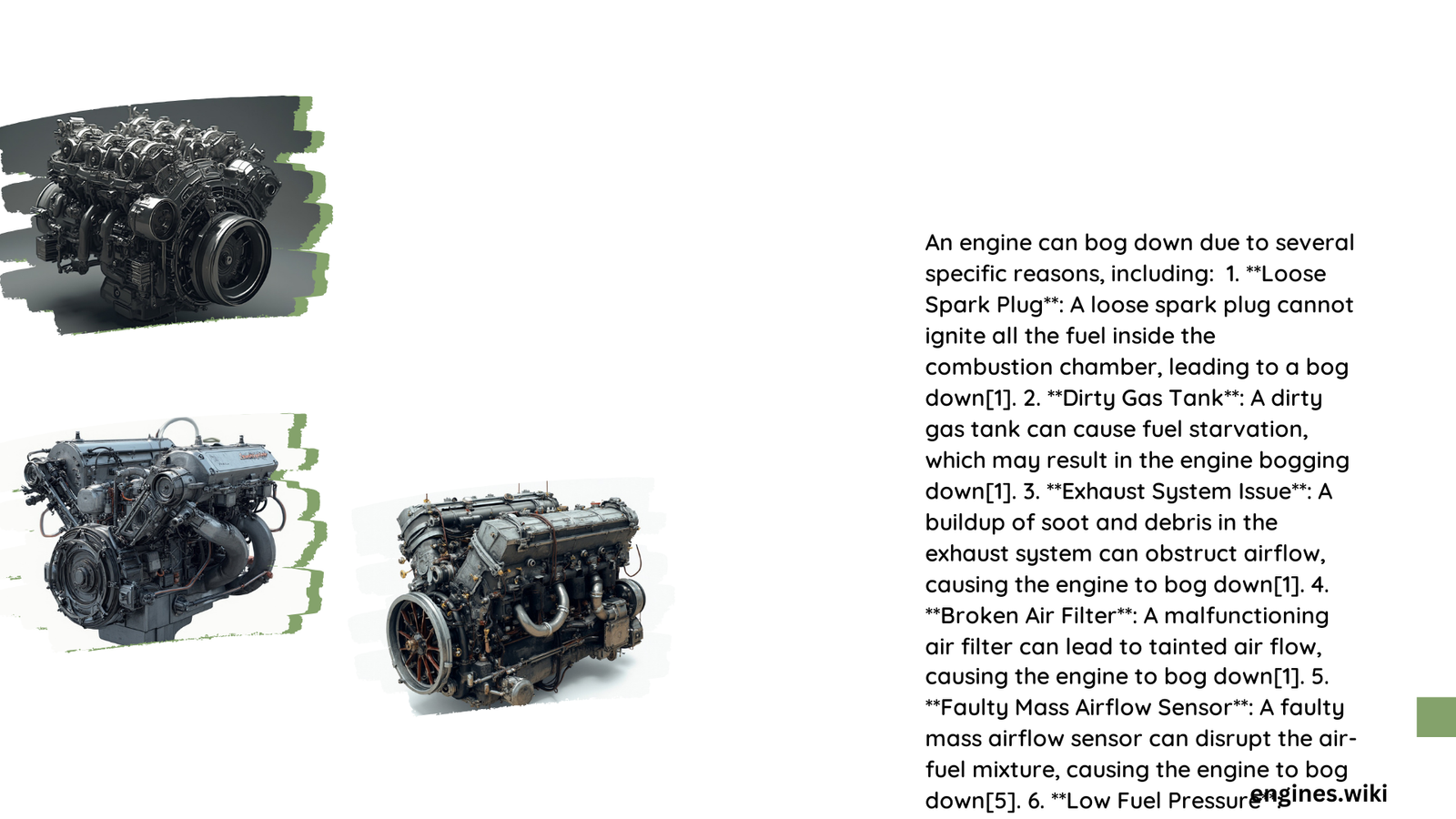An engine bogging down is a common issue that can significantly impact vehicle performance. This problem occurs when the engine struggles to maintain power or acceleration, often feeling sluggish or unresponsive. Various factors can contribute to engine bogging, including fuel system issues, air intake problems, ignition system malfunctions, and exhaust restrictions. Understanding these causes is crucial for diagnosing and resolving the issue effectively.
What Are the Specific Fuel Delivery Issues That Can Cause Engine Bogging?
Fuel delivery problems are a primary culprit in engine bogging. Here are the key aspects to consider:
How Does Fuel Pump Pressure Affect Engine Performance?
- Optimal fuel pump pressure is crucial for engine performance.
- Typical pressure range: 35-45 PSI at idle for many modern vehicles.
- Pressure should not drop significantly under load.
- A drop of more than a few PSI when accelerating indicates a problem.
What Role Do Injector Flow Rates Play in Engine Bogging?
- Clogged or dirty injectors can reduce fuel flow, causing a lean mixture.
- Flow rates are measured in pounds per hour (lb/hr) or liters per minute (L/min).
- Significantly lower flow rates than specified can lead to bogging.
At What Point Does Fuel Filter Clogging Become an Issue?
- A clogged filter restricts fuel flow to the engine.
- Look for pressure drops under load during fuel pressure tests.
- A drop of 5-10 PSI or more when accelerating suggests a clogged filter.
How Does a Clogged Air Filter Impact Engine Performance?

Air intake issues can significantly affect engine performance. Let’s examine the key factors:
What Are the Critical Airflow Restrictions to Consider?
- Airflow is typically measured in cubic feet per minute (CFM).
- A reduction of more than 20% in rated CFM can cause noticeable performance issues.
- Regular inspection and replacement are crucial for maintaining optimal airflow.
What Are the Recommended Maintenance Intervals for Air Filters?
- Inspect and replace air filters every 15,000 to 30,000 miles.
- Intervals may vary based on vehicle and driving conditions.
- Neglecting replacement can lead to reduced performance and engine bogging.
How Does Filter Condition Relate to Engine Bogging?
- A clogged filter reduces air intake, leading to a rich fuel mixture.
- This imbalance can cause the engine to bog down, especially during acceleration.
- Proper air-fuel ratio is essential for efficient combustion and performance.
What Ignition System Problems Can Lead to Engine Bogging?
The ignition system plays a crucial role in engine performance. Here are the key areas to examine:
How Do Spark Plug Gap Specifications Affect Engine Performance?
- Correct spark plug gap is essential for efficient combustion.
- Typical gap range: 0.028 to 0.060 inches, depending on the vehicle.
- Incorrect gap can cause misfires and bogging.
What Are the Ideal Coil Resistance Values?
- Primary winding resistance: typically 0.5 to 1.5 ohms.
- Secondary winding resistance: usually 5,000 to 10,000 ohms.
- Values outside these ranges can indicate a faulty coil, leading to misfires and bogging.
How Do Timing Adjustments Impact Engine Bogging?
- Correct ignition timing is crucial for combustion efficiency.
- Typical timing: around 10 degrees before top dead center.
- Advanced or retarded timing beyond specifications can cause poor combustion and bogging.
What Exhaust Restrictions Can Cause Engine Bogging?
Exhaust system issues can significantly impact engine performance. Consider these factors:
What Are Normal Back Pressure Measurements?
- Ideal back pressure: 1-2 PSI at idle, not exceeding 5 PSI under load.
- Higher pressures indicate restrictions in the exhaust system.
- Common culprits: clogged catalytic converter or muffler.
How Do Catalytic Converter Efficiency Ratings Affect Performance?
- A clogged converter can restrict exhaust flow.
- Monitor oxygen sensor readings for efficiency.
- Look for significant power drops or increased back pressure.
What Muffler Flow Characteristics Are Important?
- Mufflers should allow free flow of exhaust gases.
- Restrictions can increase back pressure and cause bogging.
- Regular inspection of muffler and tailpipe condition is crucial.
Conclusion
Engine bogging down is a complex issue with multiple potential causes. By understanding and addressing these factors – from fuel delivery and air intake to ignition system and exhaust flow – vehicle owners and mechanics can effectively diagnose and resolve performance issues. Regular maintenance and prompt attention to warning signs are key to preventing and mitigating engine bogging problems.
